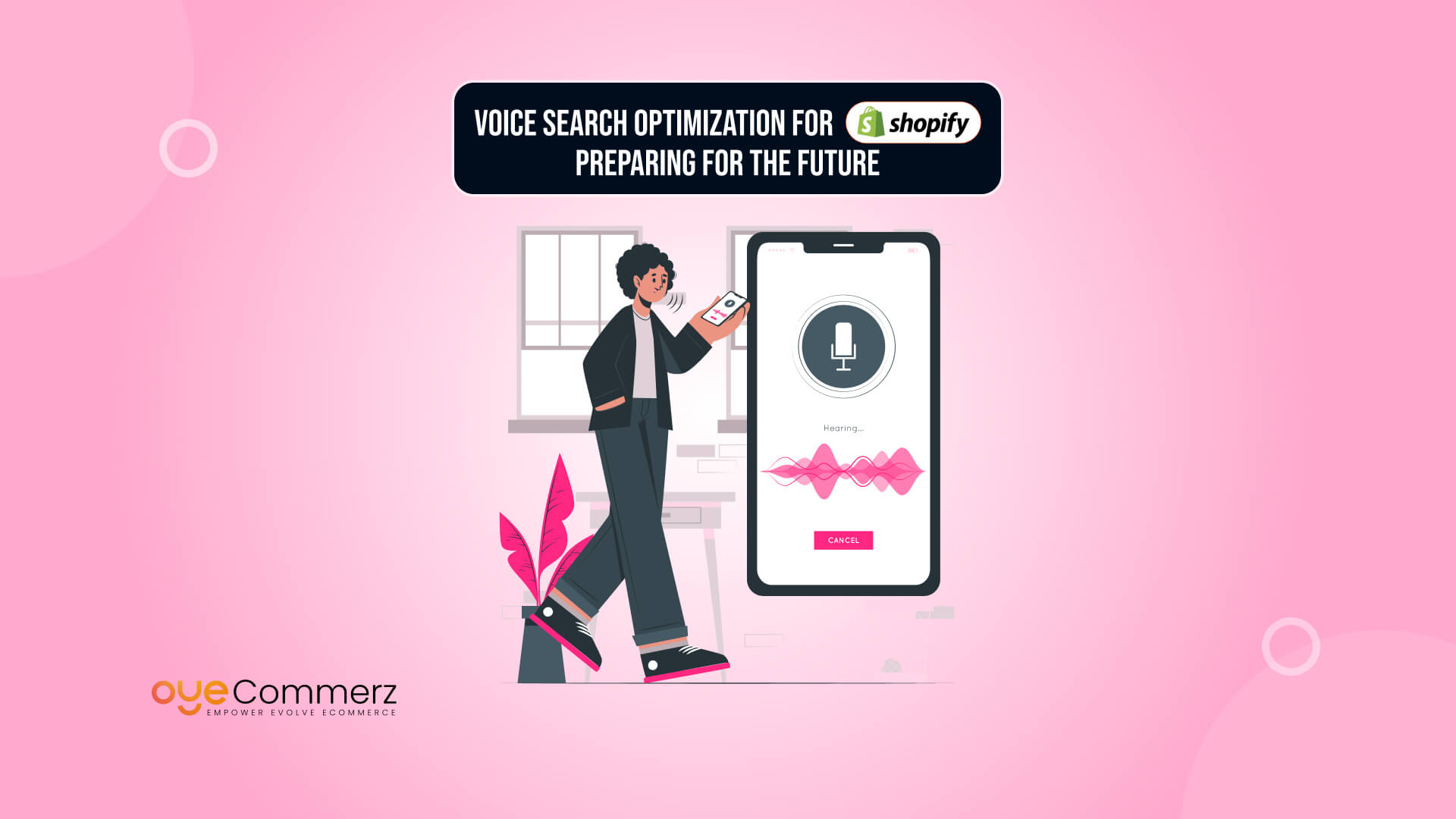Is your Shopify store ready for the voice revolution? In 2022, there were around 142 million users of voice assistants in the United States, nearly half of the country’s population. The number of voice assistant users is forecast to increase to 157.1 million users in 2026. This shift is reshaping how consumers interact with search engines, and eCommerce brands that don’t adapt are falling behind.
While Shopify offers powerful SEO tools, most stores remain unoptimized for voice-driven queries. This leads to lost organic traffic, especially from mobile users and smart speakers, who depend on quick, spoken answers over typed searches.
The solution? Implementing Voice Search Optimization for Shopify, a modern SEO approach tailored for conversational, question-based, and intent-rich queries. It bridges the gap between how people talk and how your site responds, putting your store where today’s customers are actually searching.
Let’s explore how to future-proof your store, step by step.
Table of Contents
ToggleThe Rise of Voice Technology and Its Impact on Shopify SEO
The digital landscape is shifting, and voice technology is leading the change. In the United States, the adoption rate is staggering:
- Statista reports over 135 million smart speaker users in the US by 2024, with Amazon Alexa and Google Assistant dominating usage.
- The global speech and voice recognition market is projected to grow from USD 17 billion in 2023 to USD 83 billion by 2032, at a CAGR of 20% during 2023–2032.
Changing Buyer Behavior in Voice Search
Voice queries are no longer just for weather updates or trivia questions. They are now integral to product discovery and eCommerce.
Key patterns include:
- “Near me” searches: Highly local and intent-driven, like “organic shampoo near me” or “buy men’s sneakers in LA.”
- Conversational shopping queries: Shoppers are asking full questions such as “What’s the best running shoe under $100?”
- Transactional voice search: Queries like “Order blue Nike Air Max size 9 from Shopify” are growing due to voice commerce integration.
These voice-driven interactions signal clear purchase intent, often with higher conversion potential.
Why Shopify SEO Must Adapt
Most Shopify stores are built around traditional SEO strategies, short keywords, structured metadata, and web-based behavior. However, voice search optimization demands a shift in structure and strategy:
- Long-tail, natural language keywords
- Featured snippet targeting
- FAQ schema and structured data integration
- Mobile-first design with fast load times
Voice search isn’t a passing trend, it’s a behavioral evolution. For Shopify merchants aiming to future-proof their eCommerce SEO, adapting to voice-first search habits is no longer optional; it’s critical to staying discoverable in a competitive digital market.
Voice Search Optimization: What It Means for Shopify Store Owners
Voice Search Optimization (VSO) refers to the process of enhancing your website to respond accurately to spoken queries. For Shopify store owners, this means optimizing store content and structure to rank for voice-based searches, often coming from smartphones, virtual assistants, and smart speakers.
Key Differences: Voice vs. Text SEO
The way people speak versus the way they type affects how search engines interpret intent. Here’s a technical breakdown:
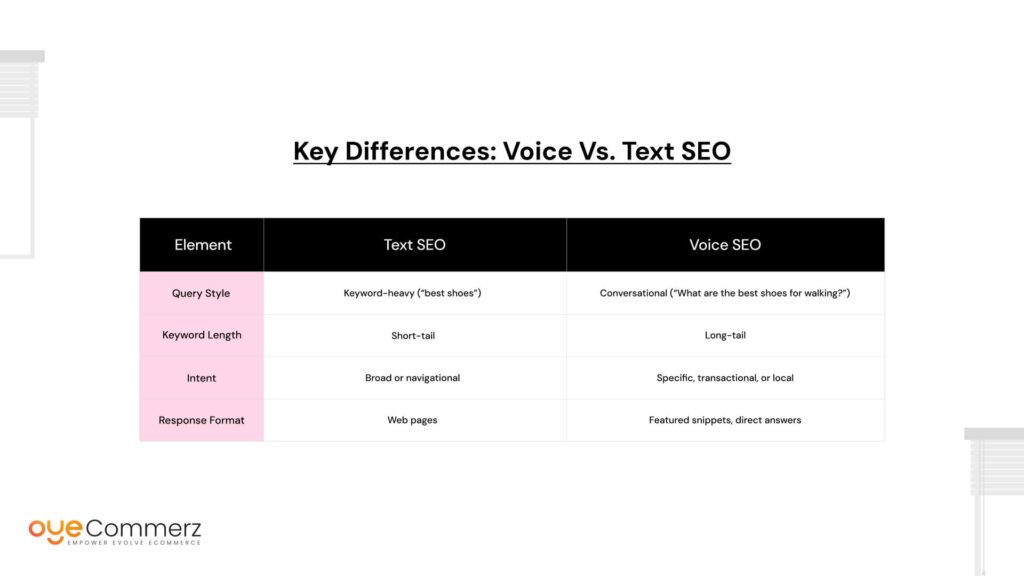
Why It Matters for Shopify Merchants
US shoppers are increasingly using voice for eCommerce activities like:
- Product discovery: “Where can I buy gluten-free pasta online?”
- Comparison: “Which is better—Shopify or WooCommerce?”
- Availability checks: “Is this dress available in medium?”
When your Shopify store isn’t optimized for these queries, you miss high-intent traffic.
Integration with Shopify SEO Strategy
Voice search doesn’t replace traditional SEO, it amplifies it. Smart store owners integrate VSO by:
- Creating FAQ sections and conversational content
- Using structured data and schema for products
- Optimizing for mobile experience and speed
- Aligning voice content with existing SEO workflows
By treating voice search optimization as an essential extension of Shopify SEO, store owners can better align with today’s buying behavior and boost their organic reach, where it matters most.
Voice Search Optimization for Shopify: The Core Benefits
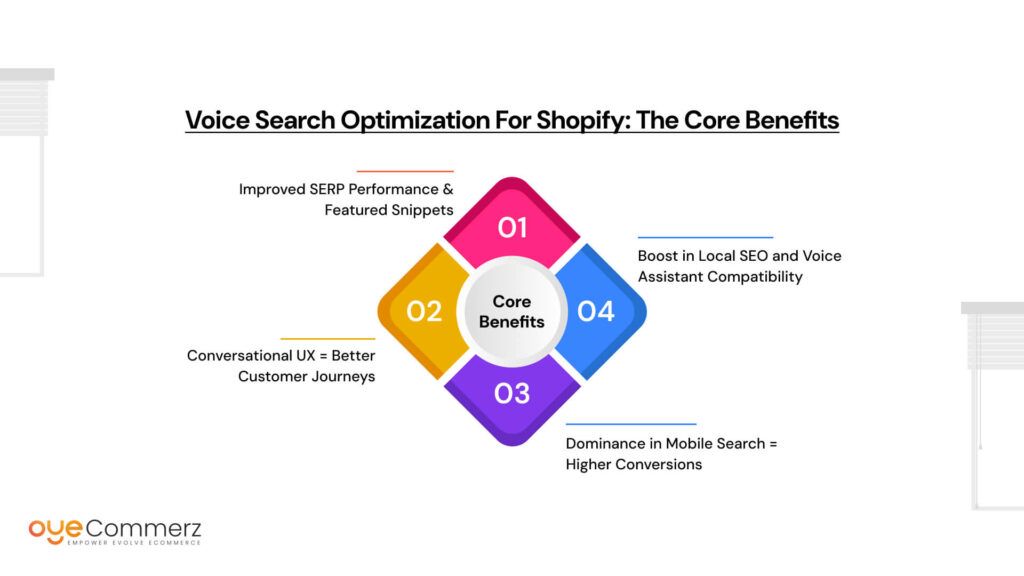
Voice search is no longer a futuristic concept, it’s a real-time shift in how consumers interact with digital storefronts. For Shopify users, embracing voice search optimization for Shopify is a gateway to unlocking multiple advantages across visibility, experience, and conversions.
1. Improved SERP Performance & Featured Snippets
Voice search relies heavily on rich results and featured snippets. Stores optimized for structured data, like product schema, FAQs, and answers, are more likely to be:
- Pulled by voice assistants (Google Assistant, Siri, Alexa)
- Ranked in Position Zero, bypassing traditional competition
- Chosen for spoken responses over standard listings
This direct delivery improves your search engine real estate while reducing dependence on paid ads.
2. Conversational UX = Better Customer Journeys
Voice queries are typically conversational and context-rich. Shopify stores that incorporate:
- Natural language product descriptions
- Long-form blog content answering questions
- Clear, structured Q&A sections
…create a frictionless shopping journey. Customers find answers faster, reducing bounce rates and increasing on-site dwell time. It’s not just about SEO, it’s about human-centered design in the voice-first age.
3. Dominance in Mobile Search = Higher Conversions
Nearly 60% of voice searches come from mobile devices, and these users are often mid-funnel or ready to purchase. Voice-optimized stores benefit from:
- Faster loading and mobile responsiveness
- Direct answers that guide shoppers to products quickly
- Clear CTAs aligned with spoken queries (e.g., “Buy now,” “Find deals,” “Add to cart”)
This shortens the click-to-buy journey significantly.
4. Boost in Local SEO and Voice Assistant Compatibility
US-based shoppers often rely on voice for local needs. Searches like:
- “Organic skincare near me”
- “Buy kids’ shoes open now in Austin”
…demand hyper-local optimization. Voice search optimization integrates seamlessly with Google Business Profile, location-based schema, and store locators, making your Shopify store more geographically discoverable.
Why It Matters
By aligning your store with how people naturally speak and search, you’re not just adapting to a trend, you’re future-proofing your visibility, boosting conversions, and ensuring your Shopify store speaks directly to the customer, literally.
Why Most Shopify Stores Are Not Ready for Voice SEO
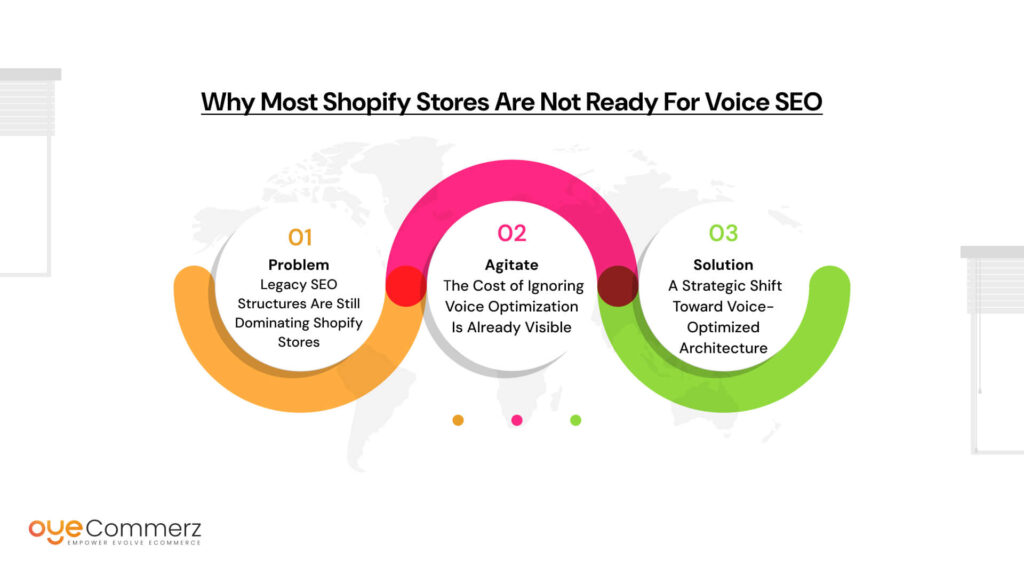
Problem: Legacy SEO Structures Are Still Dominating Shopify Stores
Shopify is a robust platform, but most store owners still rely on traditional SEO tactics:
- Short-tail keywords only
- Limited structured content
- No voice schema integration
- Static metadata written for typed input
This creates a significant disconnect between voice search behavior and website readiness. While shoppers are speaking in full questions, stores are still optimized for fragmented keyword combinations.
Agitate: The Cost of Ignoring Voice Optimization Is Already Visible
The consequences are not just technical, they’re financial and experiential:
- Missed mobile shoppers: A major chunk of organic traffic now comes via mobile voice search, and stores not optimized get ignored by assistants like Google or Alexa.
- High bounce rates: Visitors land, don’t find what they need (especially answers to spoken queries), and leave quickly.
- Poor visibility in conversational search results: Without long-tail phrases or properly marked schema, your products simply don’t show up.
- Non-structured content: Lack of bullet points, headers, and conversational context confuses crawlers that support voice.
This adds friction, limits visibility, and weakens SEO investments you’re already making.
Solution: A Strategic Shift Toward Voice-Optimized Architecture
To meet evolving search behavior, Shopify stores must transition from static keyword stuffing to dynamic, voice-aware experiences:
- Adopt long-tail keyword targeting: Focus on how people speak (e.g., “Where can I buy vegan shampoo in Chicago?”).
- Integrate structured data and schema markup: Enable voice assistants to crawl and deliver precise answers.
- Create FAQs and blog content around questions: Informational content must match voice query intent.
- Speed optimization for mobile-first indexing: Fast, responsive pages make it easier for voice interfaces to process results.
Voice SEO isn’t an accessory, it’s a core upgrade to your Shopify store’s digital strategy. The stores that act now will lead voice commerce in their niches, while others will struggle to catch up as voice search becomes the default mode of interaction.
Building Blocks: How to Align SEO for Shopify with Voice Search Optimization
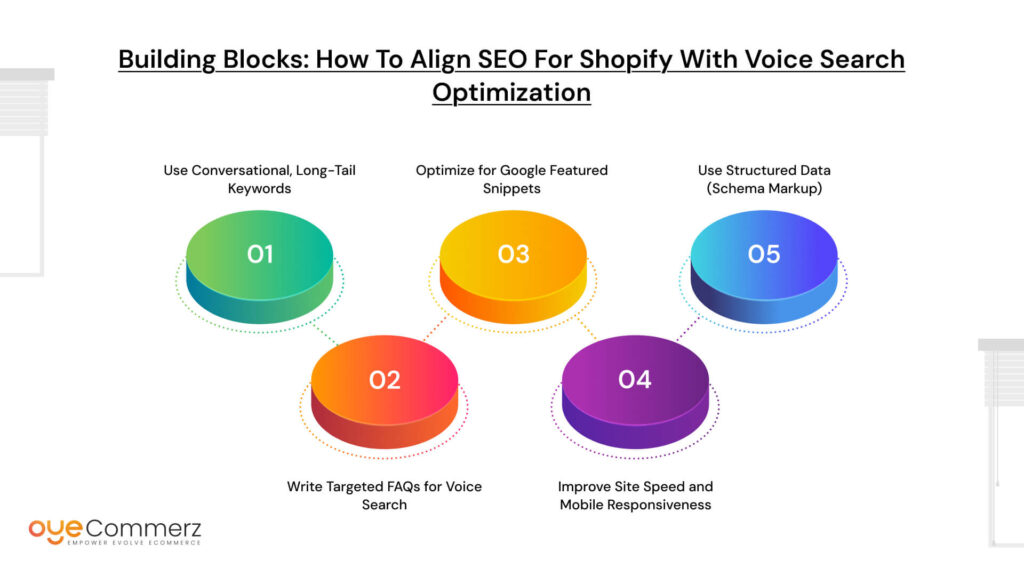
The future of SEO for Shopify hinges on how well store owners adapt to the rise of voice interactions. Implementing voice search optimization for Shopify isn’t just about keywords, it requires a strategic realignment of how your content is structured, delivered, and understood by voice assistants.
Let’s break down the five essential steps to create a voice-ready Shopify store.
a. Use Conversational, Long-Tail Keywords
Voice queries are typically 4–6 words longer than typed searches. While a text user may search “best Shopify SEO app,” a voice search user is more likely to say, “What’s the best SEO app for my Shopify store in 2025?”
How to Adapt:
- Use tools like AnswerThePublic and AlsoAsked to mine real-world voice-style questions.
- Extract actual phrases from your Google Search Console > Performance > Queries section.
- Update meta titles, product descriptions, and blog headings with these natural-speech phrases.
Voice search favors clarity. Write like you’re answering a customer directly, not stuffing keywords.
b. Write Targeted FAQs for Voice Search
FAQs are the gateway to voice snippets. Why? Because they mirror how US users phrase spoken queries.
Where to Include FAQs:
- Product Pages → “How long does this item take to ship?”
- Collection Pages → “What are the top-rated vegan skincare items?”
- Homepage → “What makes your brand sustainable?”
Formatting:
- Question in H3
- Answer: 40–45 words max, structured like a direct response
Voice assistants pull short, well-structured answers first. The more precise your answers, the higher the chance of being featured.
c. Optimize for Google Featured Snippets
Structuring your content accordingly makes it voice-friendly and Google-preferred.
Formatting Tips:
- Use numbered or bulleted lists
- Include short definitions in the first paragraph
- Create clear tables (like below) to increase clarity
Strategy:
- Start with a brief answer
- Follow up with in-depth explanation or supporting content
d. Improve Site Speed and Mobile Responsiveness
Voice search heavily prioritizes mobile speed. In fact, Google reports that over 50% of voice searches come from smartphones.
Key Metrics:
- LCP (Largest Contentful Paint) – Aim for under 2.5 seconds
- FID (First Input Delay) – Target below 100ms
Shopify Optimization Tools:
- Shopify Speed Booster – Eliminates unused scripts
- AMP Integration – Creates fast-loading mobile pages
Slow stores get skipped by voice algorithms. Google prefers to “read” results from fast-loading pages.
e. Use Structured Data (Schema Markup)
Voice assistants rely on schema to understand content contextually. Schema helps convert static HTML into machine-readable code that powers voice results, snippets, and rich cards.
Use These Schema Types:
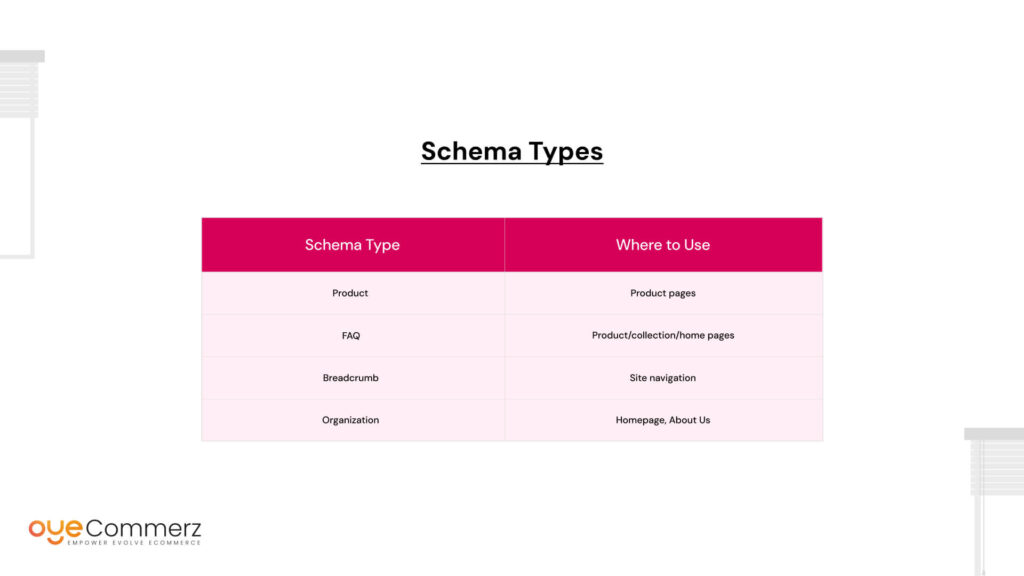
Tools:
- Google Rich Results Test – Validate schema instantly
- JSON-LD for SEO App – Easiest schema integration for Shopify
Schema is not optional, it’s the foundation of machine understanding for voice interfaces.
Voice Search vs Text Search Comparison
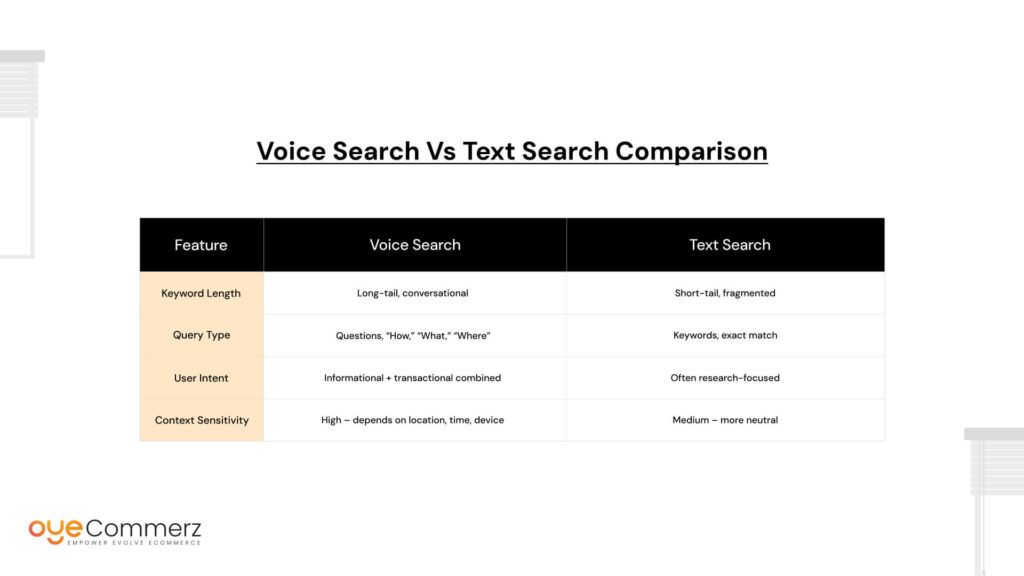
By following these steps, your Shopify store becomes voice-aware, context-ready, and positioned to rank where it counts, in the ears of your next customers.
Voice-First Content Strategy for Shopify Success
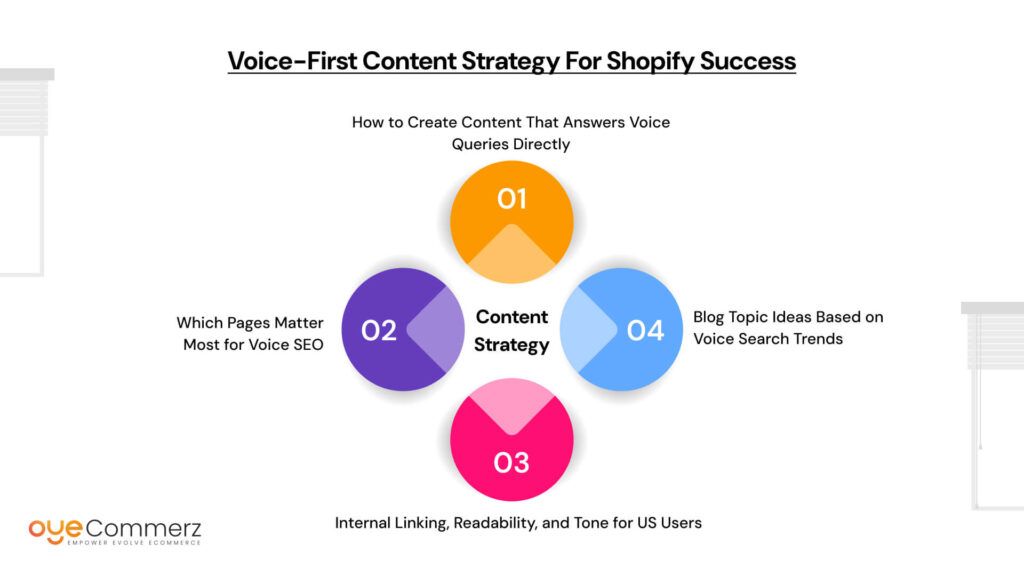
Creating a voice-first content strategy means tailoring your Shopify store’s information to match natural language queries. This isn’t just about plugging in keywords, it’s about answering your customers the way they ask questions out loud.
How to Create Content That Answers Voice Queries Directly
- Focus on question-based formats like “What is,” “How do I,” and “Where can I.”
- Prioritize direct answers within the first 40–45 words of any paragraph.
- Use simple, structured language that mimics how people speak.
Example:
Voice query: “What is the best material for yoga mats?”
Your content:
“The best material for yoga mats is TPE, as it offers durability, grip, and eco-friendliness.”
This format is voice-algorithm friendly and preferred by Google’s AI assistants.
Which Pages Matter Most for Voice SEO
To maximize results, concentrate on:
- Product Pages – Add question-based headers and FAQs (e.g., “How to use this product”)
- Blog Pages – Use long-tail voice-style titles and headers (e.g., “Why organic skincare works best in summer”)
- Landing Pages – Answer transactional queries clearly (e.g., shipping policies, return windows, eco-values)
Internal Linking, Readability, and Tone for US Users
- Ensure internal links guide users naturally through answers (e.g., from FAQ to product page).
- Aim for Grade 7–8 readability, clear, no jargon, mobile-scannable.
- Use an informative, friendly, and confident tone, ideal for US audiences and voice search responses.
Blog Topic Ideas Based on Voice Search Trends
- “What’s the best Shopify theme for fast loading?”
- “How do I track my Shopify order?”
- “Which Shopify app is best for product reviews?”
- “Where to find eco-friendly Shopify products near me?”
These mimic actual voice phrasing and improve both discoverability and snippet capture.
Technical Checklist for Voice Search SEO on Shopify
A high-performing voice search experience relies on technical SEO hygiene. Use this bullet-point checklist to ensure your Shopify store is voice-search ready.
Shopify Voice SEO Technical Checklist
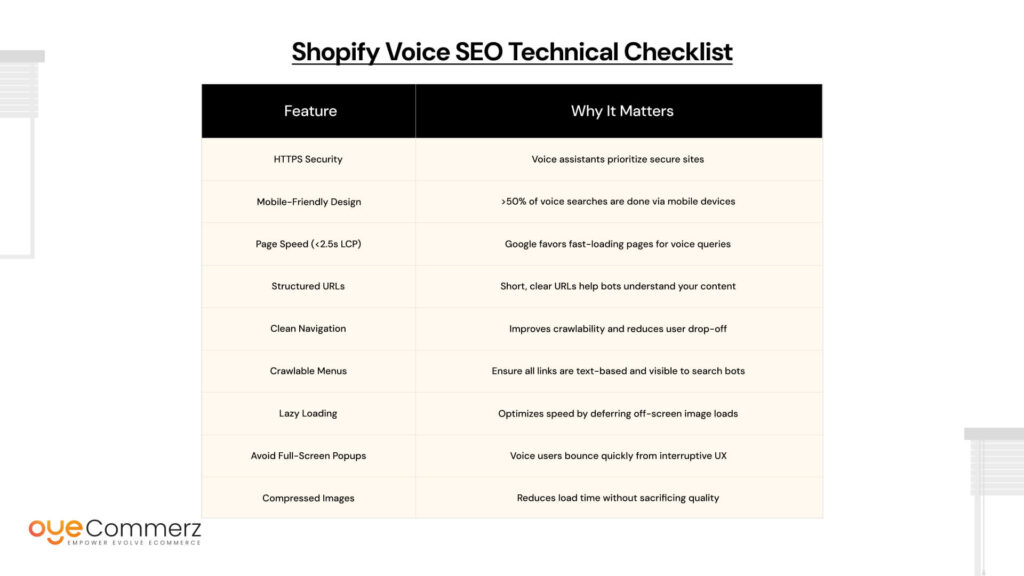
Run Google’s PageSpeed Insights, Mobile-Friendly Test, and Rich Results Test monthly to track and refine voice readiness.
Tools and Resources to Help Optimize Voice SEO for Shopify
Leverage the right tools to streamline voice search optimization for your Shopify store, especially tools that align with US market behavior and Google’s voice-first indexing.
Free Tools
- Google Search Console – Tracks actual voice-like queries (long-tail, question-based).
- AnswerThePublic – Visualizes real-world questions asked by US users.
- Google Keyword Planner – Find conversational search phrases and low-competition long-tail keywords.
Shopify Apps
- JSON-LD for SEO – Adds structured data automatically (Product, FAQ, Breadcrumb, etc.).
- Smart SEO – Generates SEO metadata with schema, ideal for featured snippet eligibility.
Browser Extensions
- SEO Meta in 1 Click – Analyze title tags, schema, headings, and meta descriptions on-page instantly.
- Wappalyzer – Check which SEO tools competitors are using on Shopify.
Content Planning Tool
- Frase.io – Helps create answer-driven content based on SERP data.
- SurferSEO – Optimizes content to hit voice-triggering keyword density and structure.
Each tool plays a role, from discovering trending voice queries to implementing structured formats that earn snippet space.
Common Mistakes Shopify Store Owners Make in Voice Search Optimization
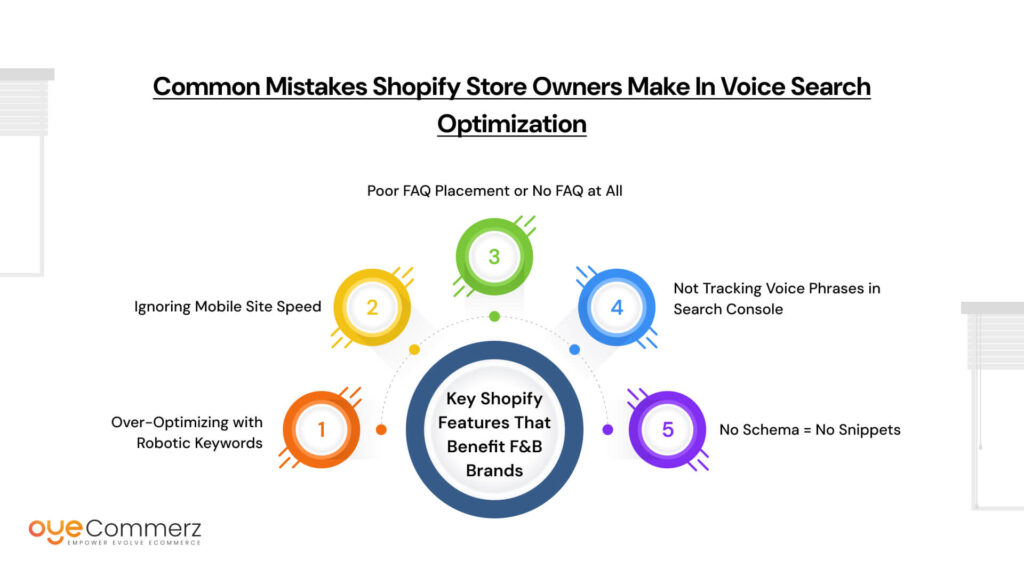
Even the most optimized Shopify store can fall short on voice readiness by overlooking key voice-centric strategies.
Over-Optimizing with Robotic Keywords
Stuffing exact-match phrases like “best cheap running shoes USA” makes content unnatural. Voice searches are conversational: “What are the best affordable running shoes for men?”
Ignoring Mobile Site Speed
Voice users expect fast responses. A site with >2.5s load time loses snippet potential and user trust. Shopify’s mobile responsiveness must be audited and optimized regularly.
Poor FAQ Placement or No FAQ at All
Voice queries often trigger FAQ snippets. Without them—or if buried deep—Google can’t surface the answer. Always add FAQs to product and landing pages with concise, structured answers.
Not Tracking Voice Phrases in Search Console
Shopify owners often miss tracking long-tail or question-based phrases in Search Console’s performance reports. Voice insights live in that data.
No Schema = No Snippets
Lack of structured data is a deal-breaker. No schema means no eligibility for rich results or voice-triggered snippets. Use JSON-LD schema apps to implement and validate markup.
Preparing for Tomorrow: Future-Proofing Your Shopify SEO Strategy
As AI assistants and voice search dominate buying behavior, early adopters will lead in Shopify’s next SEO evolution.
How AI + Voice Will Shape eCommerce SEO
AI engines (like Google SGE and Gemini) blend voice, visuals, and text. Shopify stores must shift from static product pages to conversational, interactive experiences.
Expect Google to prioritize:
- Voice-interactive featured snippets
- Fast, schema-rich pages
- Direct question-answer formats
Why Early Voice SEO Adoption Matters
- Over 40% of US adults use voice search daily (Statista, 2024)
- Voice results typically surface the top 1–3 pages only
- Early schema and FAQ adopters own snippet space before competitors join
Shopify Merchants’ Next Steps
- Create voice-first content: blogs, FAQs, landing pages
- Implement schema markup via apps
- Improve mobile experience and load time
- Track performance in GSC and optimize regularly
Voice Search Optimization for Shopify isn’t optional, it’s foundational. Future-proof your digital store now, or risk falling behind in tomorrow’s SERPs.
Ready to future-proof your Shopify store for the voice-first era?
Partner with OyeCommerz – your trusted Shopify SEO experts.
From conversational content to technical schema, we handle it all.
Let’s optimize your store for tomorrow, today!
Contact to Migrate your Site to Shopify Now
Conclusion
As voice-enabled devices become a staple in American households, optimizing your Shopify store for voice search is no longer just smart, it’s essential. Voice Search Optimization improves your visibility, captures mobile-first buyers, and enhances the overall user experience. Unlike traditional SEO, this approach helps you tap into conversational, intent-rich queries that lead directly to conversions.
By integrating voice-friendly content, structured data, and mobile-optimized speed, you position your store to lead in SERPs and future-proof your presence in the evolving digital landscape.
At OyeCommerz, we specialize in voice-driven Shopify SEO solutions tailored for U.S. markets. Don’t wait to catch up, take the leap into the future of eCommerce with us.
Frequently Asked Questions
Yes, voice search is shaping the future of SEO with rising smart device usage and demand for conversational queries.
Use long-tail, natural-sounding keywords, structured data, fast-loading mobile pages, and clear FAQs.
They are conversational, question-based, and longer phrases like “best shoes for running near me.”
SEO will be AI-driven, focused on voice, visual, and personalized search experiences across devices.
Yes, voice search relies on AI for natural language processing, understanding intent, and delivering relevant results.

